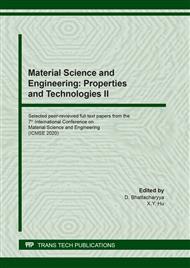[1]
Haixing LIU, Qing LIU, Yanfu SHEN. Research progress based on rhodamine-based fluorescent probes. Modern Chemical Engineering, (2017), 37(04): 197-204.
Google Scholar
[2]
Bin Zhang, Wanting Huang, XinChen Wang, et al. Research progress on fluorescent probes for rhodamine B derivatives. Journal of Jilin Medical College. (2019), 40(04): 288.
Google Scholar
[3]
Yongzhi Lv, Xueyi Feng, Luxiang Liu et al. Review of the luminescence mechanism of fluorescent probes. Fujian Analytical Testing, (2017), 26(02): 25-30.
Google Scholar
[4]
Jing Qian,Kan Wang, Chengquan Wang, et al. Ratiometric fluorescence nanosensor for selective and visual detection of cadmium ions using quencher displacement-induced fluorescence recovery of CdTe quantum dots-based hybrid probe . Sensors Actuators Chemical. (2017), 241: 1153-1160.
DOI: 10.1016/j.snb.2016.10.020
Google Scholar
[5]
Ting Dong, Ling Lei, Bo Zhang. Progress in the preparation and application of rhodamine-like mercury ion fluorescent probe. Modern Salt Chem. (2017), 44(05): 18-21.
Google Scholar
[6]
Pieter Martens, Frederik Verbrugge, Petra Nijst, et al. Impact of Iron Deficiency on Response to and Remodeling After Cardiac Resynchronization Therapy. The American Journal of Cardiology. (2017), 119(1): 65-70.
DOI: 10.1016/j.amjcard.2016.09.017
Google Scholar
[7]
Gandhi Sivaraman, Murugan Iniya, Thangaraj Anand, Niranjan G. Kotla, et al. Chemically diverse small molecule fluorescent chemosensors for copper ion. Coordination Chemistry Reviews. (2018), 357: 50-104.
DOI: 10.1016/j.ccr.2017.11.020
Google Scholar
[8]
Jinyan ZHANG, Zhaotong WAN, Yuxin WEI, et al. Research progress of mercury ion fluorescent probe. Shandong Chemical Industry, (2018), 47(11): 48-50.
Google Scholar
[9]
Zhenli GUO, Yang YANG, Jinglin LIU, et al. Synthesis of rhodamine Schiff base fluorescent probe and its application in the detection of Cu2+ and Fe3+. Petrochemical, (2019), 48(09): 963-967.
Google Scholar
[10]
Rui Qiao, WenZhang Xiong, CuiBing Bai, et al. A highly selective fluorescent chemosensor for Fe (III) based on rhodamine 6G dyes derivative. Supramolecular Chemistry. (2018), 30(11): 911-917.
DOI: 10.1080/10610278.2018.1467016
Google Scholar
[11]
Yi Huang, Meipan Yang, Weihong Zhang, et al. Specific recognition of Fe3+ by rhodamine-like Schiff base fluorescent probe. Chemical Research and Applications. (2018), 30(01): 90-96.
Google Scholar
[12]
Huie Jiang, Zhijian Li, Yifan Kang, et al. A two-photon fluorescent probe for Cu2+ based on dansyl moiety and its application in bioimaging. Sensors & Actuators: B. Chemical. (2017), 242: 112-117.
DOI: 10.1016/j.snb.2016.11.033
Google Scholar
[13]
Linlin Lv, Quanping Diao. A highly selective and sensitive rhodamine-derived fluorescent probe for detection of Cu2+. Spectrochimica Acta Part A: Molecular and Biomole. (2017), 179: 221-226.
DOI: 10.1016/j.saa.2017.02.053
Google Scholar
[14]
Jing LIU, Guanghua TANG, Huan WANG, et al. Synthesis and recognition performance of rhodamine Ag+ fluorescent probe based on off-on mechanism . Journal of Chemical Engineering in Universities, (2018), 32(04): 949-955.
Google Scholar
[15]
Yan Song, Fangfei Wang, Linyuan Zhou, et al. Cu2+ fluorescence/colorimetric sensor based on rhodamine derivatives . Journal of Jilin Institute of Chemical Technology, (2019), 36(01): 70-74.
Google Scholar
[16]
Ting Lv, Yongqian Xu,Hongjuan Li, et al. A Rhodamine B-based fluorescent probe for imaging Cu2+ in maize roots. Bioorganic & Medicinal Chemistry. (2018) 26(8): 1448-1452.
DOI: 10.1016/j.bmc.2017.09.026
Google Scholar
[17]
Xiao Qian. Synthesis of rhodamine-type fluorescent probes and their recognition of Hg2+ . Chemical Reagents, (2017), 39(11): 1221-1224.
Google Scholar


